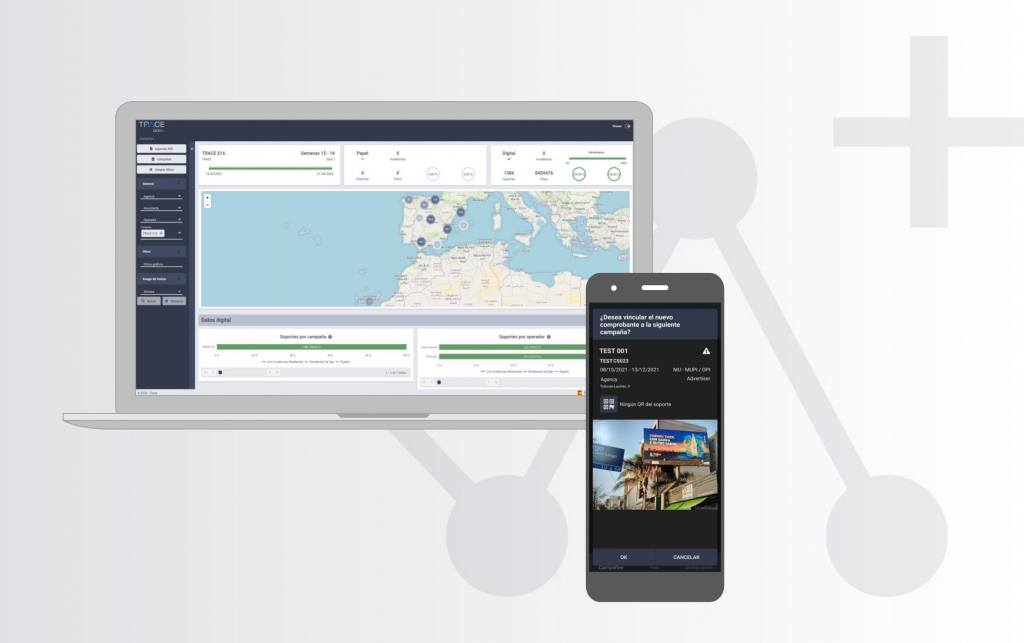
OOH Trace Launches Platform Designed To Provide Transparency, Immediacy To DOOH Campaign Reporting
May 6, 2022 by Dave Haynes
A start-up put together by a former Posterscope executive has launched a solution it says provides a real-time audit trail for out of home advertising – both digital and analog.
Developed by Carlos Viladevall, who spent 13 years as CEO of media planning giant Posterscope’s Spain business, OOH TRACE uses proprietary code embedded into creative files to track and report via a simple dashboard whether the right campaign creative plays where and when it was booked.
Not tied to media companies, content management systems or programmatic platforms, the idea is that OOH Trace provides “an independent platform for real-time, Poof-of-Posting/Proof-of-Play verification of outdoor advertising creative campaigns.”
“Our focus,” explains Viladevall, “is to help outdoor media increase trust and value, by creating a first-level content display verifier for any ad campaign throughout its duration, across all markets, and across all vendors. I am sure that the use of OOH TRACE will bring increased consistency to the management and impact on the return that the outdoor media provides to advertised brands.”
Viladavell’s simple description is a snippet of code – what he called a pixel, but stressed it is not – that gets attached to creative prior to the ad being scheduled and distributed. That nominal piece of code allows OOH TRACE to track a wealth of information about the state of the ad – primarily if it is the correct ad, playing in the correct location, and according to the other scheduling parameters. Embedding the code snippet with creative “takes milliseconds,” Viladavell says.
The software does not have to be directly integrated with DOOH software platforms like Broadsign or Vistar, and the only technical speed bump to tracking ads running on the networks of the big OOH media companies is firewall access. So assuming the display is on a network, and it can call home (so to speak), that code snippet can report on what’s happening.
“We are not analyzing,” Viladevall explains, “the quality or audience of the medium, but whether the creative message is rendered in its entirety as contracted. OOH TRACE identifies whether the content is there or not, other sources will measure and evaluate the audiences.”
The company’s dashboard shows, via mapping, the details of the different outdoor media formats and panels used, all of them geolocated, as well as complete creative placement specification details. AI/machine learning help do things like compare campaign details against deliverables.
For printed posters and billboards, the platform uses photos, geolocation and image recognition.
There have been all kinds of efforts through the years to provide full, accurate proof-of-play reporting on digital OOH campaigns, and I have bumped into things like code snippets and little sensors looking for specific pixels or just light to verify screens are on. Viladevall isn’t professing this is an entirely new concept, but a different, better approach.
Companies like Broadsign have deep campaign reporting capabilities, but it’s not likely many media planners want to learn how to use a CMS (Broadsign is very powerful, but you don’t just launch that UX and know what to do). More generally, campaign reporting tools tend to provide a calendar snapshot of what happened AFTER the fact.
Viladevall says the two trends driving his service direction are a demand and expectation for transparency from media companies and networks, and a media landscape that wants and expects immediacy – as in planners want to know what’s happening with their booked campaigns now, in real time, as opposed to once a campaign ends.
The service is SaaS-based, and is now available in seven countries: France, Belgium, Luxembourg, Brazil, the United States, Canada, and Spain via local partners. OOH Trace plans to be in at least eight more markets.



Leave a comment